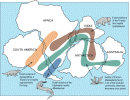Wilberforce verifiable facts of creationism
Here's your chance to present them.
Moderators: kiore, Blip, The_Metatron
•
53 posts
• Page 3 of 3 • 1, 2, 3
Re: Wilberforce verifiable facts of creationism
Would rabbits in the cretaceous be a verifiable fact of creationism? Or just a misstep in evolution?
"We cannot slaughter each other out of the human impasse"
- Clive Durdle
- Name: Clive Durdle
- Posts: 4874
- Country: UK

Re: Wilberforce verifiable facts of creationism
Clive Durdle wrote:Would rabbits in the cretaceous be a verifiable fact of creationism? Or just a misstep in evolution?
Evidence against the current evolutionary model. Nothing to do with creationism. It is only certain silly creationists that think that evidence against evolutionary theory automatically counts as evidence for creationism.
Reason Over Faith
-

ADParker - RS Donator
- Name: Andrew
- Posts: 5643
- Age: 52

- Country: New Zealand

Re: Wilberforce verifiable facts of creationism
ADParker wrote:Clive Durdle wrote:Would rabbits in the cretaceous be a verifiable fact of creationism? Or just a misstep in evolution?
Evidence against the current evolutionary model. Nothing to do with creationism. It is only certain silly creationists that think that evidence against evolutionary theory automatically counts as evidence for creationism.
Not even that. Fossils belonging to the Lagomorpha go back to the Paleocene, which means that an extension to the upper Cretaceous isn't even that unlikely - in particular since the molecular evidence suggest that the basal splits in the Lagomorpha did take place in the Cretaceous. So in terms of the fossil record, it would be interesting, but not shocking to see cretaceous Lagomorphans and in terms of the molecular data it would fit right in.
susu
- susu.exp
- Posts: 1690
Re: Wilberforce verifiable facts of creationism
I'm going to take a guess that Clive meant the Precambrian, in line with Haldane's suggestion of evidence that could falsify the evolutionary account.
I'm not an atheist; I just don't believe in gods :- that which I don't belong to isn't a group!
Religion: Mass Stockholm Syndrome
Learn Stuff. Stuff good. https://www.coursera.org/
Religion: Mass Stockholm Syndrome
Learn Stuff. Stuff good. https://www.coursera.org/
-

Spearthrower - Posts: 33854
- Age: 47

- Country: Thailand
Re: Wilberforce verifiable facts of creationism
Clive Durdle wrote:Would rabbits in the cretaceous be a verifiable fact of creationism? Or just a misstep in evolution?
You're thinking of J. B. S. Haldane's famous rejoinder, when asked what would falsify the current evolutionary paradigm. He replied gruffly, "Fossil rabbits in the Precambrian".
EDIT: Spearthrower just beat me to the post.
Signature temporarily on hold until I can find a reliable image host ...
-

Calilasseia - RS Donator
- Posts: 22629
- Age: 62

- Country: England

Re: Wilberforce verifiable facts of creationism
What would that really mean, though? Rabbits in the Precambrian. Honestly, at this point I would theorize future time travel before the invalidation of the entire evolutionary theory. It would just go so far against all other recorded data...
User formerly known as Falconjudge.
I am a Christian.
I am a Christian.
-

Zadocfish2 - Name: Justin
- Posts: 608
- Age: 32

- Country: USA

Re: Wilberforce verifiable facts of creationism
So rabbits in the cretaceous is a possible, pre cambrian probably a stretch! I assumed Haldane would have given a comparison with where there were larger critters!
"We cannot slaughter each other out of the human impasse"
- Clive Durdle
- Name: Clive Durdle
- Posts: 4874
- Country: UK

Re: Wilberforce verifiable facts of creationism
Only an error of what, a billion years or 25%!
"We cannot slaughter each other out of the human impasse"
- Clive Durdle
- Name: Clive Durdle
- Posts: 4874
- Country: UK

Re: Wilberforce verifiable facts of creationism
Clive Durdle wrote:So rabbits in the cretaceous is a possible, pre cambrian probably a stretch! I assumed Haldane would have given a comparison with where there were larger critters!
To be clear: actual rabbits in the cretaceous would also be quite problematic, albeit nowhere near as problematic as finding them in the Precambrian. Susu is talking about a common ancestor with modern rabbits and hares - that their lineage goes back to the Cretaceous, not that actual rabbits were present.
Haldane's comment wasn't about the size of the creatures involved but of their taxonomic hierarchies. It's plausible that the basal bilateria were present in the Precambrian, but something like a mammal couldn't have existed without our narrative of evolution being profoundly wrong.
I'm not an atheist; I just don't believe in gods :- that which I don't belong to isn't a group!
Religion: Mass Stockholm Syndrome
Learn Stuff. Stuff good. https://www.coursera.org/
Religion: Mass Stockholm Syndrome
Learn Stuff. Stuff good. https://www.coursera.org/
-

Spearthrower - Posts: 33854
- Age: 47

- Country: Thailand
Re: Wilberforce verifiable facts of creationism
Time-travelling rabbits?

"Bunch together a group of people deliberately chosen for strong religious feelings,
and you have a practical guarantee of dark morbidities." - H.P. Lovecraft
-

Varangian - RS Donator
- Name: Björn
- Posts: 7298
- Age: 59

- Country: Sweden

Re: Wilberforce verifiable facts of creationism
Was there a rabbit hutch on the Tardis?
And I can't remember my time paradoxes - isn't leaving rabbits in the pre cambrian like killing your grandfather?
But I still haven't got a verifiable fact of creationism, and are we discussing Marduk or Zeus?
And I can't remember my time paradoxes - isn't leaving rabbits in the pre cambrian like killing your grandfather?
But I still haven't got a verifiable fact of creationism, and are we discussing Marduk or Zeus?
"We cannot slaughter each other out of the human impasse"
- Clive Durdle
- Name: Clive Durdle
- Posts: 4874
- Country: UK

Re: Wilberforce verifiable facts of creationism
Clive Durdle wrote:So rabbits in the cretaceous is a possible, pre cambrian probably a stretch! I assumed Haldane would have given a comparison with where there were larger critters!
Size isn't the issue. What is the issue here, is that the emergence of various anatomical features, upon which our classification of organisms is largely based, thus far follows a well-defined timetable. Back in the Precambrian, recognisable vertebrates were not present, although basal chordates were starting to put in an appearance in the Ediacaran. None of these basal chordates possessed a bony skeleton, though, let alone any of the other features associated with mammals. The first true bony fish, in the form of the jawless Ostracoderms, do not appear in the fossil record earlier than the early to middle Silurian. Jawed fishes (Placoderms) first appear in the late Silurian. The first tetrapods capable of locomotion on land do not appear until the late Devonian. Animals recognisable as basal amphibians do not appear until the early Carboniferous. The first reliably recognisable amniotes do not date back earlier than the early Permian, which form the foundation for the emergence of reptiles. The first reptiles exhibiting mammal-like anatomical features do not date back earlier than the late Permian. The earliest recognisable true mammals date no earlier than the late Triassic. The earliest reliably recognisable placental mammals date no earlier than the late Jurassic. The first animals reliably recognisable as Leporids do not appear until the early Eocene.
Consequently, finding an anatomically modern Lagomorph fossilised in a Precambrian stratum, possessing anatomical features not previously found in any coeval taxon, and pre-dating the earliest known appearance of some of those features by over 400 million years, would be a sensational find if it ever occurred, and one that would lead to a LOT of questions being asked, the moment it was established that said fossil was indeed the genuine article and not a fake. Such a fossil would either lead to a stupendous reassessment of our understanding of the biosphere, or lead, as some here have stated, to asking questions about the physical possibility of time travel.
Indeed, the latter would be a lot more likely, because one would then have to ask, why these anatomically modern rabbits left NO descendants for 500 million years or more. Indeed, given that terrestrial plants are not regarded as having emerged until the Ordovician, one would have to ask what the hell the organism leaving behind that fossil ate, given that plausible food organisms for that fossil rabbit didn't appear until at least 100 million years after the fossil rabbit in question. There's also the question of how such an organism would even be able to breathe, in an atmosphere that contained considerably less oxygen than the present day atmosphere - most of the oxygen arising from photosynthesis would still be dissolved in the oceans in Precambrian epochs. This paper provides some relevant data, which includes data obtained from such sources as enucleated bubbles of air trapped inside various media in the epochs in question, so that, for example, we know that the oxygen content of the atmosphere in the Jurassic and early Cretaceous was considerably higher than present, from analysing the composition of air bubbles trapped in amber during those epochs. Other chemical evidence is brought into play to determine the atmospheric content of the Precambrian (indeed, this was an important determining factor in the emergence of the Neoproterozoic "Snowball Earth" hypothesis, which is currently the only satisfactory explanation for multiple lines of evidence obtained from the relevant strata).
The complete absence of terrestrial food sources for such an organism (which would have left fossils themselves if they existed), the significantly different terrestrial atmospheric composition, the complete absence of any simpler temporal antecedents pointing to the emergence of such an organism, would all point to the organism in question being far more likely to have arrived via interference on the part of time travelling humans, than to the falsity of evolution.
Signature temporarily on hold until I can find a reliable image host ...
-

Calilasseia - RS Donator
- Posts: 22629
- Age: 62

- Country: England

Re: Wilberforce verifiable facts of creationism
susu.exp wrote:ADParker wrote:Clive Durdle wrote:Would rabbits in the cretaceous be a verifiable fact of creationism? Or just a misstep in evolution?
Evidence against the current evolutionary model. Nothing to do with creationism. It is only certain silly creationists that think that evidence against evolutionary theory automatically counts as evidence for creationism.
Not even that. Fossils belonging to the Lagomorpha go back to the Paleocene, which means that an extension to the upper Cretaceous isn't even that unlikely - in particular since the molecular evidence suggest that the basal splits in the Lagomorpha did take place in the Cretaceous. So in terms of the fossil record, it would be interesting, but not shocking to see cretaceous Lagomorphans and in terms of the molecular data it would fit right in.
A basal lagomorph sure, but it would be harder to fit in if we were talking about a fossil that was unambiguously indistinguishable from some extant species of rabbit. Needless to say, no such fossil (or a similar situation in other families) has ever been found.
Half-Life 3 - I want to believe
-

Rumraket - Posts: 13264
- Age: 43
53 posts
• Page 3 of 3 • 1, 2, 3
Who is online
Users viewing this topic: No registered users and 1 guest